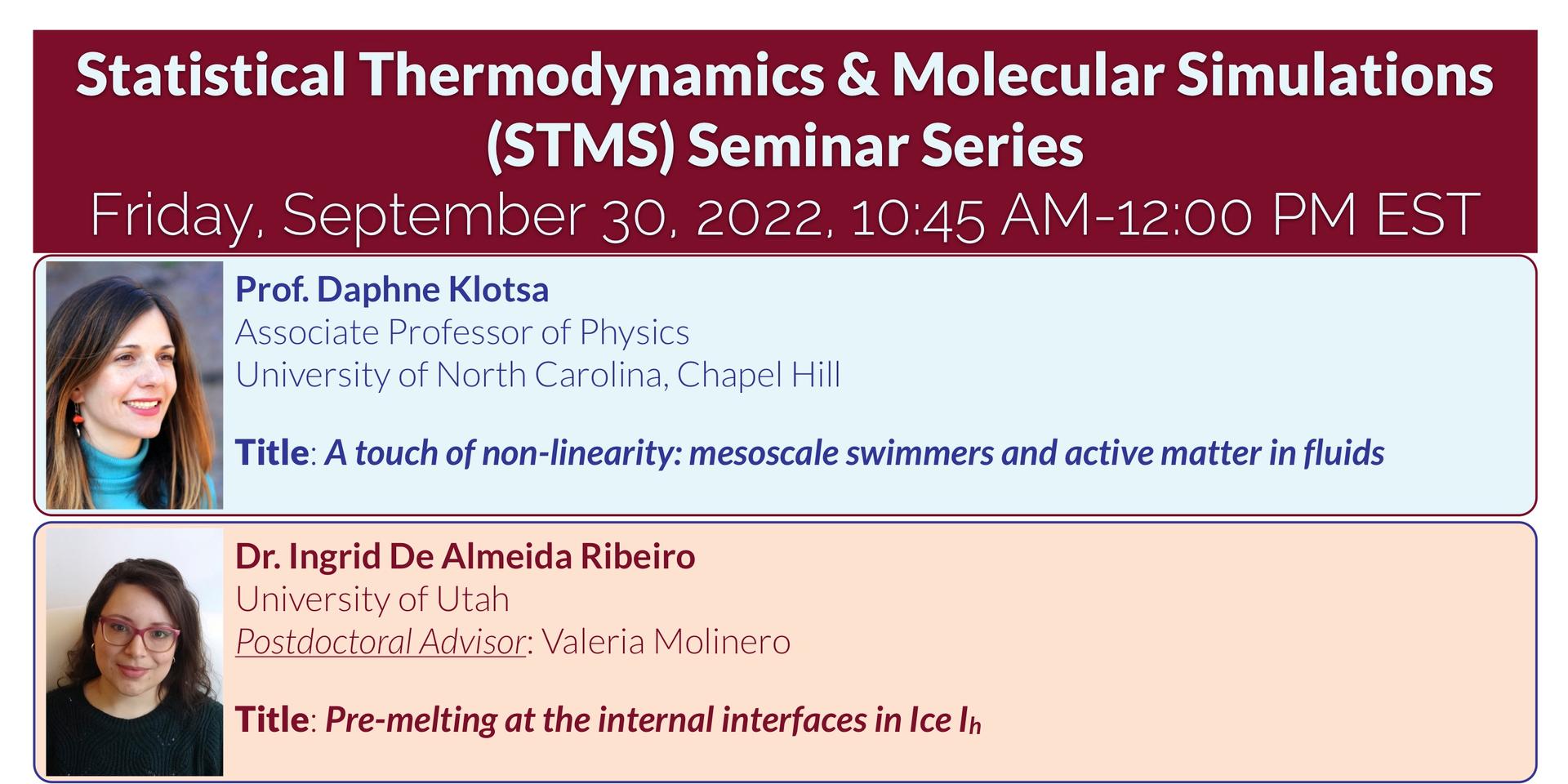
Statistical Thermodynamics & Molecular Simulations (STMS) Seminar Series
These seminar series are aimed at providing a virtual platform for sharing scientific research in the area of statistical mechanics, molecular simulations, and computational materials science. Since early 2020, the coronavirus pandemic has disrupted many large in-person scientific gatherings, including conferences and department seminars, and it is not clear that the situation will improve any time soon. STMS is aimed at filling this gap, and provide a venue for dissemination of research findings and exchange of ideas in the age of COVID. This model is being currently used by several other scientific communities, and can potentially continue even beyond the pandemic if successful.
Each seminar will be a 60-minute event and will comprise of a long-form (30-minute) talk by a principal investigator or a senior research scientists from academia or industry and a short-form (15-minute) presentation by a graduate student or a postdoc. The remainder of the event will be dedicated to Q&A (10 minutes for the PI, 5 minutes for the student/postdoc). Long-form speakers will be chosen by the STMS Organizing Committee, while we encourage suggestions from the community at large. Student and postdoctoral speakers can either be nominated by their advisors or can self-nominate themselves by sending a CV to the organizers. During 2022 we expect to hold two seminar per month, and the events will take place in the last two Fridays of each month, from 10:45 AM-12:00 PM Eastern Standard Time (EST):
This event's talks:
A touch of non-linearity: Mesoscale swimmers and active matter in fluids
Prof. Daphne Klotsa (University of North Carolina, Chapel Hill)
Abstract: Living matter, such as biological tissue, can be seen as a nonequilibrium hierarchical assembly of assemblies of smaller and smaller active components, where energy is consumed at many scales. The functionality and versatility of such living or "active-matter" systems render it a promising candidate to study and to synthetically design. While many active-matter systems reside in fluids (solution, blood, ocean, air), so far, studies that include hydrodynamic interactions have focused on microscopic scales in Stokes flows, where the active particles are <100μm and the Reynolds number, Re <<1. At those microscopic scales viscosity dominates and inertia can be neglected. However, what happens as swimmers slightly increase in size (say ~0.1mm-100cm) or as they form larger aggregates and swarms? The system then enters the intermediate Reynolds regime where both inertia and viscosity play a role, and where nonlinearities in the fluid are introduced. In this talk, I will present a simple model swimmer used to understand the transition from Stokes to intermediate Reynolds numbers, first for a single swimmer, then for pairwise interactions and finally for collective behavior. We show that, even for a simple model, inertia can induce hydrodynamic interactions that generate novel phase behavior, steady states and transitions.
Speaker Bio: DK is an associate professor in the department of applied physical sciences at the University of North Carolina at Chapel Hill. DK did her undergraduate and master's degrees at the University of Warwick (in the UK) and her PhD at the University of Nottingham, all in physics. She got a three-year Marie-Curie postdoctoral fellowship, which she held at the University of Michigan, Harvard and Cambridge University, where she worked with Sharon Glotzer, Michael Brenner and Daan Frenkel respectively. She moved to the university of north Carolina at chapel hill in 2015, first as an assistant professor and now as associate. DK has received an NSF Career award, and leads grants from the Army Research Office, and the Department of Energy. She is also involved in the American Physical Society, where she is secretary/treasurer in the Group of Statistical and Nonlinear Physics.
Pre-melting at the internal interfaces of Ice Ih
Dr. Ingrid De Almeida Ribeiro (University of Utah)
Abstract: Abstract: Due to the relevance of glaciers and ice sheets to the Earth climate, it is fundamental to model and understand how these large ice masses behave. In this context, the study of mechanical deformation processes is an important step. For instance, grain-boundary (GB) sliding during polycrystalline ice flow is one of the mechanisms of creep. From the microscopic point of view, GB melting is one of the most important and least studied subjects of pre-melted ice. The challenge lies in directly observing the networks composed by the GBs in ice at the molecular level. In this talk, I will address the pre-melting phenomena in coincident-site-lattice GBs in ice Ih for temperatures just below the melting point using molecular simulations. I will answer how the liquid-like nature of these internal interfaces affects friction in GB sliding processes.
Speaker Bio: Dr. Ribeiro is a postdoctoral scholar in the department of Chemistry at the University of Utah advised by Prof. Valeria Molinero. Dr. Ribeiro’s current research focuses on using tools of non-equilibrium statistical mechanics, simulations, and theory to study the ice nucleation on biological surfaces. Prior to this, she received B.Sc. in Computational Physics from Federal Fluminense University in 2015, M.Sc. in Physics from the University of Campinas in 2017, and Ph.D. in Physics from the University of Campinas in 2021. During her Ph.D., Dr. Ribeiro investigated mechanical properties of ice Ih as well as structural and dynamical properties of supercooled water using MD simulations under the supervision of Prof. Maurice de Koning.